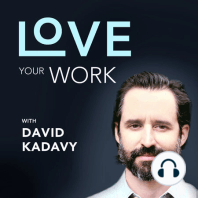36 min listen
272. Ode to the Unfinished
FromLove Your Work
ratings:
Length:
12 minutes
Released:
Feb 10, 2022
Format:
Podcast episode
Description
There’s a reason the expression, “unfinished business” has such provocative power. Unfinished projects stack up like skeletons in our cluttered mental closets. We know if we crack open that door, we’ll be reminded of our failed intentions, our foolish optimism, and our broken promises – to others and to ourselves. But unfinished business doesn’t get the credit it deserves. Unfinished projects are a valuable and necessary part of the creative process. They build skills and plant seeds of ideas for future projects. And even when a project seems as if it’s unfinished, sometimes it’s not. The iPhone came from unfinished business We wouldn’t have the iPhone if it weren’t for unfinished business. When Steve Jobs set out to make a phone that didn’t suck, he drew upon unfinished projects, and he left unfinished projects in his wake. The iPhone we know and love – and all the imitation ancestor smartphones it spawned – may seem like an obvious invention. But at the start of the project, it was far from obvious. A trackwheel phone!? From the beginning, the iPhone was built upon the foundation laid by the iPod. The iPod had transformed Apple’s business. iPod sales were forty-five percent of Apple’s revenue in 2005. But in the early 2000s, when you left the house, you had a dilemma: Do I bring my phone, my digital camera, my iPod – or some combination of the three? Jobs had seen how the digital camera market was getting eaten up by phones that had cameras. That was one less device you had to carry with you. He knew the iPod’s market share would erode, too, as soon as there was a decent phone that could hold music. If Apple could develop that phone, they could stay alive. So the first iPhone prototypes looked like iPods. You’d use the iPod’s then-famous trackwheel not only to navigate through menus, but also to select letters to type with, or numbers to dial the phone. Fortunately, this trackwheel phone became unfinished business. But the winning prototype also created unfinished business. The iPhone killed the iPad After toying with the trackwheel phone for months, it became apparent that Apple might want to explore another approach. So, Jobs and the other executives assigned another team to develop a different prototype. This time, they would develop a multitouch prototype – one where you’d actually use your fingers on a screen to interact with the phone. Apple had been experimenting with touch for many years now, such as when they developed their trackpad. There was one project they already had in the works that they borrowed from to develop the iPhone we know today. Apple had been working on a tablet computer with multitouch technology. Not only would you touch the screen on this tablet to “click” on items, or drag them around, but it could also sense various gestures, such as swipes, or even multiple fingers. So, Apple drew upon the technology from this tablet-computer project to use that technology in their phone project. They essentially placed what would become the iPad on hold, thus making more unfinished business. Creativity is messy Let’s stop for a second to think about how horrible it would be to use a trackwheel phone. You’d have to run your thumb over a trackwheel circle to find the letter you’d want to type, then click on the center of the wheel to select the letter. Or, you’d have to click on the right part of the circle to activate the corresponding letter. You’d have to do this to dial phone numbers, or select applications, enter names into your address book, or – God forbid – to write text messages. It’s obvious to us now this is a horrible idea. But that’s because we’ve used the iPhone. Creativity is a messy process. What will later seem an obviously bad or great idea will not be obviously such when you’re in the thick of a project. Want proof? In the process of making history, the smartest product designers and engineers in the world, including Steve Jobs, spent months exploring a trackwheel phone. Not only that, but
Released:
Feb 10, 2022
Format:
Podcast episode
Titles in the series (100)
25. Steve Case: Persevere in "The Third Wave" – how entrepreneurs will transform entrenched industries: Steve Case is the former CEO of AOL – America Online. Many of you probably chuckle when you see someone with an email address that ends in AOL.com, but for me and many millions of others, AOL was our first contact with the Internet. Steve has a... by Love Your Work
